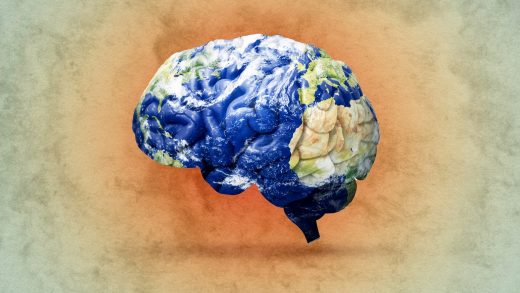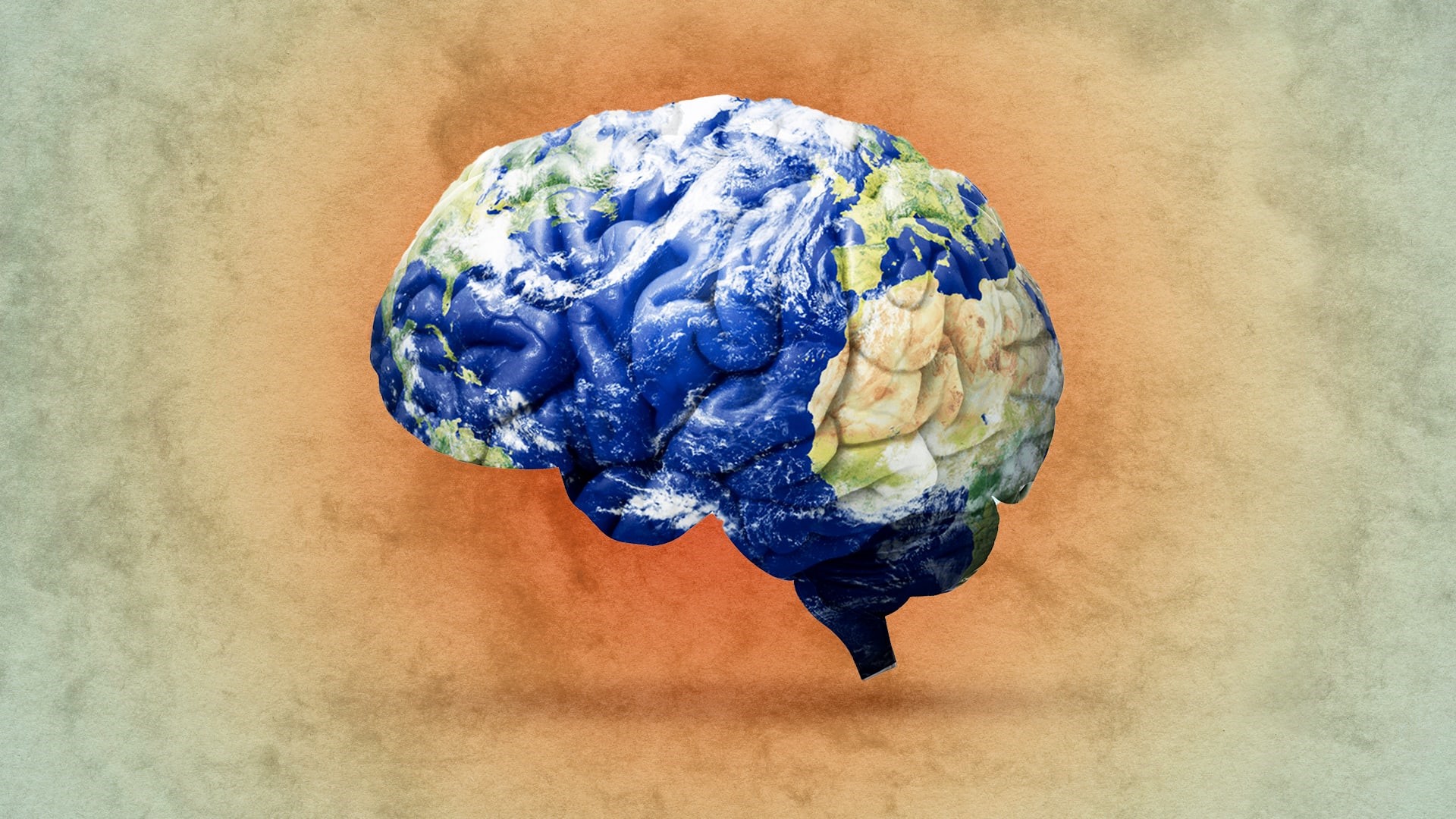This is what climate change does to your brain, according to a neuroscientist
This is what climate change does to your brain, according to a neuroscientist
Five reasons climate change brain is a real neurological landscape, from the author of ‘The Weight of Nature.’
Clayton Page Aldern is a former neuroscientist turned environmental journalist. He is currently a senior data reporter at the climate media site Grist. His work focuses on the intersection of climate change and human health, particularly the neurological impacts of environmental factors.
Below, Aldern shares five key insights from his new book, The Weight of Nature: How a Changing Climate Changes Our Brains. Listen to the audio version—read by Aldern himself—in the Next Big Idea App.
1. Your brain models the world.
To navigate your environment, you must possess an innate sense of how it all fits together. If you’re to survive out there in the concrete jungle, gravity can’t surprise you. You need to understand that when water falls from clouds, it doesn’t mean the sky is falling with it. Your brain helps build and store these kinds of predictions about the ways of the world.
These predictions are within you. In other words, you are a model—a picture of what’s out there. But the picture isn’t static. From moment to moment, to sustain your existence, your brain compares the predictions of its world model to the sensory information it receives, tweaking its inner workings to minimize surprise. You look around, feel about, move hither and thither—all the while expecting things to go a certain way. When they don’t, you update your model accordingly.
The goal is to minimize the mismatch between what you expect to experience at any given moment and what you actually experience. If your brain didn’t seek to minimize surprise, you’d be pathologically dumbstruck every moment of every day. You would forget that people generally have two arms; you would be terrified to learn your hands are attached to your body and that the sky is such a remarkable shade of blue.
But instead of surfacing a constant state of shock, your model learns to expect these kinds of things so it can focus on the interesting stuff. Modeling the world allows us to understand that we are still alive and that reality looks roughly the way we expect it to look.
Our conscious access to this model—our feelings and knowledge—allows us to use our brains and bodies as tools to sustain themselves. That’s an important point: An understanding of yourself as a model builder necessarily invokes the brain and the rest of the body. Cognition is literally embodied. The stuff of thought is physical stuff. It is exposed to the world and it makes itself in its image. As the environment changes, you should expect to change too. It is the job of your brain to model the world as it is. And the world is mutating.
2. Environmental factors drive behavior.
Heat can have a profound impact on behavior, often in subtle and surprising ways. As I discuss in the book, higher temperatures have been linked to increased aggression and impulsivity across a wide range of species. Lemon damselfish, for instance, become more aggressive when water temperatures rise—and the effect is seen in every individual fish. In humans, too, heat seems to short-circuit our senses and decision-making capacities. Studies have shown that on hotter days, baseball pitchers are more likely to hit batters in retaliation, and immigration judges reject more asylum applications.
The neurological mechanisms are complex but may involve heat’s ability to disrupt serotonin function in the brain, a phenomenon that has been tied to impulsive violence. Cognitively, heat also appears to act as a kind of “load” on our attention systems, making us more distractible and impairing functions like problem-solving and emotional regulation.
Ultimately, our brains prioritize survival in the heat—even if that means sacrificing some of our most prized cognitive abilities. It’s an evolutionary trade-off with major implications as the world warms. By understanding heat’s intimate effects on the mind, we can better grasp the human dimensions of climate change.
Air pollution, too, unleashed by wildfires for example, can infiltrate our minds and shape our behavior in alarming ways. Economically, it’s been shown to dampen productivity among everyone from farm workers to call center employees. But the effects run deeper: Air pollution has been linked to impaired learning and memory, reduced test scores in high schoolers, and even unethical behavior like cheating. The tiny particulates in polluted air can spark inflammation in the brain, impairing cognition and decision-making. These impacts often fall disproportionately on low-income communities, highlighting the entanglement of environmental and social justice. As with heat, confronting air pollution means reckoning with its unseen yet pervasive influence on our inner worlds.
3. Climate change spreads brain disease.
In the tangled web of global warming’s health impacts, one of the most insidious and unsettling threads is the spread of brain disease. As rising temperatures and shifting weather patterns reshape ecosystems, they’re not just altering landscapes—they’re creating new opportunities for neurological ailments to flourish and spread.
One major pathway is through the expansion of zoonotic diseases. As climate change nudges animal populations into new territories and closer proximity to humans, the potential for pathogen spillover grows. Mosquito-borne illnesses like Japanese encephalitis and Zika, for example, are hitching a ride into new regions as their insect vectors expand their ranges. Warmer temperatures are often a boon for these disease carriers, allowing them to live in once-inhospitable areas and reproduce more rapidly.
Climate change is also awakening dormant dangers like the brain-eating amoeba Naegleria fowleri. As waters warm, these microbes can bloom in freshwater sources, entering the brain via the nasal cavity and causing devastating meningoencephalitis. While infections are rare, they’re almost invariably fatal—a stark reminder of the high stakes in our warming world.
Another threat lurks in the rising tide of neurotoxins. As harmful algal blooms expand in both frequency and geographical spread, so too does the reach of toxins like BMAA—a compound linked to neurodegenerative diseases like ALS and Alzheimer’s. These toxins can bioaccumulate up the food chain. Even more troubling, though, evidence suggests these toxins may be going airborne, drifting in sea spray and dust. No longer confined to the dinner plate, they’re becoming an inescapable part of the atmosphere. Combined with the rising scourge of mercury, another potent neurotoxin being released from thawing permafrost, the neurological burden of climate change is becoming increasingly difficult to avoid.
Taken together, these threats paint a worrying picture. As the planet heats up, so too does the risk of brain diseases—and often it’s the most vulnerable among us who are at greatest risk. Tackling this challenge will require a concerted interdisciplinary effort: one that recognizes the deep interconnections between planetary and human health. It’s a tall order but one we cannot afford to ignore. After all, our minds may quite literally depend on it.
4. Mental health reflects planetary health.
In the intricate dance between mind and world, our mental well-being is intimately intertwined with the health of the planet. The psychological toll of a warming world is becoming increasingly apparent, etched into the contours of our collective psyche.
Consider the plight of communities on the front lines of environmental degradation. As rising seas swallow coastlines and drought parches fields, the mental health burden is immense. The existential distress caused by environmental change is an all-too-real phenomenon linked to heightened rates of anxiety, depression, and even suicide. For these communities, the scars of climate change are not just physical but deeply psychological.
Even for those not immediately in the path of, say, a hurricane, the specter of climate change looms large. Eco-anxiety, the chronic fear of environmental doom, is on the rise, particularly among young people. It’s a generational trauma, a weight carried by those who will inherit a world in chaos. This pervasive sense of dread and helplessness is a mirror held up to a planet in peril.
But the mental health impacts of climate change are not just about anxiety and despair. As natural disasters become more frequent and severe, rates of post-traumatic stress disorder are climbing. The terror of a wildfire or the devastation of a hurricane can leave deep psychological wounds long after the physical damage is repaired. These mental scars are a reflection of a world increasingly defined by upheaval and uncertainty. We also know that experiencing extreme environmental stress in utero (such as living through a hurricane) can drastically increase a child’s risk of anxiety, depression, conduct disorders, and attention deficit hyperactivity disorder, or ADHD. These epigenetic effects are likely heritable as well.
Ultimately, our mental health is a barometer of planetary health. As the world around us unravels, so too do the threads of our psychological well-being. Addressing this crisis will require a paradigm shift—one that recognizes the fundamental interconnectedness of mind and nature. It’s a recognition that in healing the planet, we may also begin to heal ourselves. After all, as the adage goes, there is no health without mental health—and perhaps no mental health without a healthy planet.
5. Mindfulness matters.
At its core, mindfulness is about cultivating a deep embodied awareness—a way of being fully present to the reality of our experience. And in a world increasingly shaped by climate change, this capacity for presence has never been more essential.
On an individual level, the neuroscience of mindfulness offers a really compelling case for its transformative potential. Training the brain to focus on the present moment can serve as a powerful counterweight to the impulsivity and distractibility effects of environmental stressors, as well as the anxiety and despair that often accompany eco-distress. Studies have shown that mindfulness increases gray matter density in regions associated with learning, memory, and emotion regulation, such as the hippocampus and prefrontal cortex, while reducing the size and reactivity of the amygdala, that primal seat of fear and reactivity. Functional connectivity between brain regions that regulate attention and executive control is enhanced, leading to better emotional regulation. Mindfulness also decreases activity in the default mode network, which is linked to mind-wandering, thereby improving present-moment awareness.
But the benefits of mindfulness extend far beyond the individual. In fostering a deeper awareness of our interconnectedness with the world around us, mindfulness can serve as a catalyst for action. By attuning us to the subtle web of cause and effect that binds us to the planet, it can inspire a renewed sense of responsibility and stewardship. Mindfulness, in this sense, is not just about finding inner peace—it’s about awakening to the reality of our ecological embeddedness.
This awakening is all the more crucial in light of the neurological impacts of climate change. Imagine a world where the mental health implications of climate change were given the same urgency as its physical impacts. Where awareness was not just a personal practice but a societal value woven into the fabric of our institutions and decision-making processes.
This is the world that mindfulness invites us to create. A world where we are fully present to the reality of the crisis yet not paralyzed by despair. Where we can hold the grief and the beauty, the fear and the possibility in equal measure. Where we can face the enormity of the challenge with clear eyes and maybe even open hearts.
In the end, mindfulness matters because it offers us a way to face the reality of climate change—to face it squarely without flinching, and respond with wisdom and compassion. It is a radical act of presence in a world that would rather look away. And in that presence, we may find the clarity and courage to build a better future—for ourselves, each other, and the planet we call home.
This article originally appeared in Next Big Idea Club magazine and is reprinted with permission.
ABOUT THE AUTHOR
Fast Company
(13)



